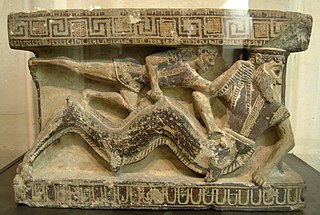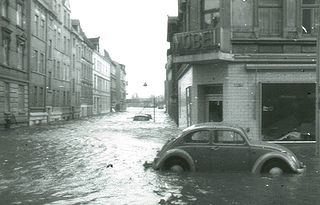
Georg Philipp Telemann was a German Baroque composer and multi-instrumentalist. Almost completely self-taught in music, he became a composer against his family's wishes. After studying in Magdeburg, Zellerfeld, and Hildesheim, Telemann entered the University of Leipzig to study law, but eventually settled on a career in music. He held important positions in Leipzig, Sorau, Eisenach, and Frankfurt before settling in Hamburg in 1721, where he became musical director of that city's five main churches. While Telemann's career prospered, his personal life was always troubled: his first wife died less than two years after their marriage, and his second wife had extramarital affairs and accumulated a large gambling debt before leaving him.

Triton is a Greek god of the sea, the son of Poseidon and Amphitrite, god and goddess of the sea respectively. Triton lived with his parents in a golden palace on the bottom of the sea. Later he is often depicted as having a conch shell he would blow like a trumpet.

The Burchardi flood was a storm tide that struck the North Sea coast of North Frisia and Dithmarschen on the night between 11 and 12 October 1634. Overrunning dikes, it shattered the coastline and caused thousands of deaths and catastrophic material damage. Much of the island of Strand washed away, forming the islands Nordstrand, Pellworm and several halligen.

The North Sea flood of 1962 was a natural disaster affecting mainly the coastal regions of Germany and in particular the city of Hamburg in the night from 16 February to 17 February 1962. In total, the homes of about 60,000 people were destroyed, and the death toll amounted to 315 in Hamburg. The extratropical cyclone responsible for the flooding had previously crossed the United Kingdom as the Great Sheffield Gale, devastating the city of Sheffield and killing nine people.

The sculptures in the Schönbrunn Garden at Schönbrunn Palace in Vienna, Austria were created between 1773 and 1780 under the direction of Johann Wilhelm Beyer, a German artist and garden designer. The Great Parterre of Schönbrunn Garden is lined on both sides with 32 over life-size sculptures that represent mythological deities and virtues. The Neptune Fountain at the foot of the Gloriette hill is the crowning monument of the Great Parterre. Other sculptures are distributed throughout the garden and palace forecourt, including fountains and pools. Several sculptors were employed during the execution of these works, among them Johann Baptist Hagenauer.

Hamburger Admiralitätsmusik TWV 24:1 is a secular oratorio for soloists, choir and orchestra composed by Georg Philipp Telemann to celebrate the 100th anniversary of Hamburg's admiralty. It was first performed on April 6, 1723, along with Telemann's Wassermusik at a banquet for the city's merchants, sea captains, and councillors that lasted until dawn. The work is on a nautical theme and set to verses by Michael Richey, a professor at the Johanneum school in Hamburg where Telemann also taught.

Between 1716 and 1767, Georg Philipp Telemann wrote a series of Passions, musical compositions reflecting on Christ's Passion – the physical, spiritual and mental suffering of Jesus from the hours prior to his trial through to his crucifixion. The works were written for performance in German churches in the days before Easter. A prolific composer, Telemann wrote over 40 Passions for the churches of Hamburg alone, of which 22 have survived according to the present state of research. He also wrote several Passion oratorios. Unlike the Passions intended for liturgical performance, they were not closely set to the literal text of the Gospels.

Der Tod Jesu is an oratorio libretto by Karl Wilhelm Ramler. In its setting by Carl Heinrich Graun in 1755, it was the most often performed Passion of the 18th century in Germany.
Michael Schneider is a German flautist, recorder player, conductor and academic teacher. He is especially connected with later Baroque repertoire such as the works of Telemann and with early Classical repertoire such as the works of Carl Philipp Emanuel Bach, and founded the orchestra La Stagione to perform and record such repertoire.

Zerreißet, zersprenget, zertrümmert die Gruft or Der zufriedengestellte Aeolus, BWV 205.1, BWV 205, is a secular cantata or dramma per musica by Johann Sebastian Bach. It was written for the name day of August Friedrich Müller, and was first performed on 3 August 1725. The libretto by Picander is based on Greek mythology.

Gensericus oder Sieg der Schönheit TVWV 21:10 is a comic German-language opera in three acts by Georg Philipp Telemann. It was performed at the Oper am Gänsemarkt, while Keiser was director. Unlike Orpheus and Flavius Bertaridus, the opera contains no Italian-language set piece arias. The librettist was Christian Heinrich Postel.
Siehe, es hat überwunden der Löwe, TWV 1:1328, BWV 219, is a church cantata by Georg Philipp Telemann, written for Michaelmas in 1723. Formerly the cantata was accredited to Johann Sebastian Bach.

The Brockes Passion, or Der für die Sünde der Welt gemarterte und sterbende Jesus, is a German oratorio libretto by Barthold Heinrich Brockes, first published in 1712 and going through 30 or so editions in the next 15 years.
Water Music is a 1717 composition by George Frideric Handel. It may also refer to:
The Telemann-Werke-Verzeichnis, abbreviated TWV, is the numbering system identifying compositions by Georg Philipp Telemann, published by musicologist Martin Ruhnke.

In Greek mythology, Aeolus, the son of Hippotes, was the ruler of the winds encountered by Odysseus in Homer's Odyssey. Aeolus was the king of the island of Aeolia, where he lived with his wife and six sons and six daughters. To ensure safe passage home for Odysseus and his men, Aeolus gave Odysseus a bag containing all the winds, except the gentle west wind. But when almost home, Odysseus' men, thinking the bag contained treasure, opened it and they were all driven by the winds back to Aeolia. Believing that Odysseus must evidently be hated by the gods, Aeolus sent him away without further help. This Aeolus was also sometimes confused with the Aeolus who was the son of Hellen and the eponym of the Aeolians.

The Telemann Museum is a museum in the Composers Quarter in Hamburg-Neustadt, Germany. It was founded in 2011 and is dedicated to the classical composer Georg Philipp Telemann.
Gustav Fock was a German music historian, editor early music and organologist. He is considered the most important Schnitger researcher of his time.











